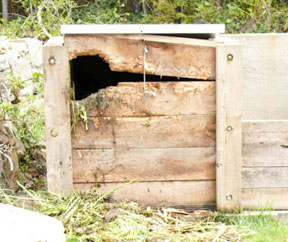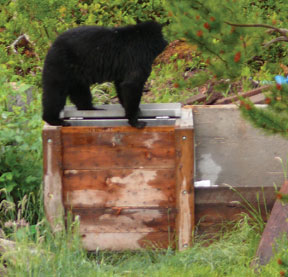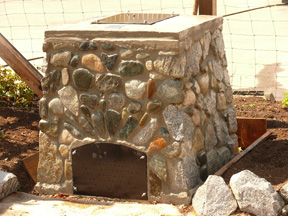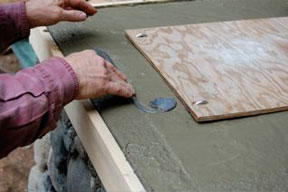ARE YOU AFRAID TO COMPOST BECAUSE OF BEARS?
You live in a natural setting because you care about the environment.
But you can't compost, because the plastic bins you put out are magnets for everything on four legs, from rats, to racoons and from skunks to bears.
You'd like to complete the life cycle, from your garden to your kitchen, and back into your garden, in the form of rich, composted "black gold."

But if you're going to feed your vegetables with compost, you'll have to buy it, because you can't safely compost in your own back yard.
I’m Laurie Chambers. I live in Lund, just north of Powell River on the west coast of Canada, where black bears still live in the woods.

Here’s a picture of a composter I built out of two-inch cedar boards, with a heavy aluminum plate top. It took a bear 20 minutes to make this hole.
Next I built a composter of three-inch thick seasoned fir, with the nail heads pointed out, to discourage scratching. But it’s a lot of nails, and it looks ugly. This is a mother bear about to have a snack from that composter.

This time she didn’t have to claw her way in, because someone forgot to properly latch the lid, so she flipped it out of the way.
I feel strongly about the way our garbage habits are hurting the planet. I also like bears. Bears that get used to seeing the composter as a feeding station can be dangerous, and for that reason, a lot of them are killed.
THE SOLUTION
It was a big problem, the kind that requires a complete rethinking. This composter is made using concrete formwork, faced with stone, with recessed bolts holding aluminum lid, front door and back vent in place. As unique as it looks, this design uses proven methods for producing compost.

It’s a bonus that it turned out to be beautiful, but it did. Apart from being critter-proof, this is more than likely the first composter ever made that’s equal on the outside to the beauty of what’s going on inside: the transformation of organic wastes into rich, life-giving compost.
IT WORKS
Right now there are 20 of these composters in use in and around Powell River. They've all gone through at least one full bear season. Bears have shown interest, but once they check it out, they know they can't get inside, and they go away. And the compost these bins produce is the best of black gold.
HOW DOES IT WORK?
Inside, there’s a screen angled across the bottom of the bin that allows air from the ventilation hole at the bottom of the back of the bin to move up through the compost and out through a vent at the top. Because hot air rises, the heat of the compost constantly flows out through the top vent and pulls cooler air in from the bottom. You don’t need to turn it, but it certainly helps to punch holes in it with a pointed stick or preferably a wingdigger. You do need to treat it like any other composter, and layer in an appropriate mix of kitchen wastes and carbon sources, such as dry leaves, sawdust or shredded newspapers, and soil with lots of life, not sand, to control odors and capture valuable nitrates. Core samples taken on the bins already in use are showing great results: rich, fully digested compost. Food does not decompose as quickly as in a rotating bin, but it has more organic life in it. Like slow food, slow composting has a lot to recommend it.
HOW I SEE THIS GROWING
I've completed an instruction manual, HOW TO BUILD A CRITTER-PROOF COMPOSTER. The manual has been successfully used by builders of varying skill levels.
It has:
- step-by-step instructions, with full color photographs for each step
- scale drawings of the forms.
- a separate shopping list of supplies
- a checklist of tools, so you’ll have them all on hand before you start
If you're already sure you want to start Critter-Proof Composting, you can have the e-book on your computer within five minutes, just by hitting the "Buy Now" button in the box below.
Once your payment of $39 + tax has been made, you'll receive an email with a link to download the manual.
If you'd like to know more, then click here.
DO IT YOURSELF PROJECTS
If you’re handy enough to cut plywood, pour concrete and drill holes in aluminum, this could be a great project for a family or a group of friends. Everyone can help collect the stones and place them. Building the forms will take you two hours, and they can be re-used many times. Putting the composter together once everything’s assembled takes about 15 hours spread over three days.

On the third day, you’ll have an heirloom composter with a wet concrete top surface that’s as irresistible for personalizing as a freshly poured sidewalk. Handprints of the whole family? Beautiful tiles or stones? Names and dates? “No Bears Allowed” written in the wet cement?
NOT THE HANDY TYPE?
If you live on the south coast of B.C., Critter-Proof Composting™ will build a composter for you. Prices vary. The range starts at $450 for people who live near Powell River and supply their own stones.
As soon as possible, we’re hoping to spread the Critter-Proof Composter™ plans to independent contractors all over North America. Once we do, we’ll list every contractor on our website so you can find someone in your own area.
Do you have the skills? If you would like to make money while building something beautiful and ecologically positive, email me at Lauritz@critterproofcomposting.com.
Once you’re on our list, you’ll be the first to know when the instruction manual is available. Learn more about the new bins as we build them, and keep up to date with Critter-Proof Composting™ news.

